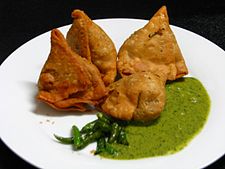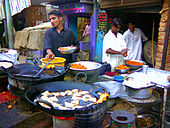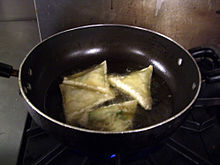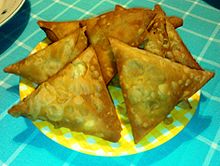- Samosa
-
- For the Nicaraguan dictator(s), see Somoza
Samosa 
Samosa with chutney from Raipur, Chhattisgarh, IndiaOrigin Alternative name(s) Samsa, somsa, sambosak, sambusa, samoosa, singada, samuza Region or state Indian Subcontinent, Central Asia, Western Asia, the Horn of Africa, North Africa, South Africa Dish details Main ingredient(s) maida, potato, onion, spices, green chili, cheese, meat Variations Chamuça A samosa is a stuffed pastry and a popular snack in the Indian Subcontinent, Southeast Asia, Central Asia and Southwest Asia, the Arabian Peninsula, the Mediterranean, the Horn of Africa, North Africa and South Africa. It generally consists of a fried or baked triangular, semilunar or tetrahedral pastry shell with a savory filling, which may include spiced potatoes, onions, peas, coriander, and lentils, or ground lamb or chicken. The size and shape of a samosa, as well as the consistency of the pastry used, can vary considerably, although it is mostly triangular. Samosas are often served with chutney[citation needed] generally as an appetizer. Given the popularity of Indian cuisine, samosas are widely available in Indian restaurants and snack-bars in Europe, North America, Asia and Africa.
Contents
Name Variation
Samosa (Hindi: समोसा) (English pronunciation: /səˈmoʊsə/) is generally used in the Indian Subcontinent and Southeast Asian countries. Other names are used in other areas: Bengali: সিঙাড়া singara, Oriya: ષ્હિઙદ shingada, Punjabi: ਸਮੋਸਾ, Gujarati: સુમૉસ sumosa, Kannada: ಸಮೋಸಾ samosa, Malayalam: സമോസ, Marathi: समोसा, Tamil: சமோசா, Urdu: سموسه, sambusak (Arabic: سمبوسك sambūsak), samsa (pronounced [ˈsamsə]) or somsa in Turkic Central Asia (Kyrgyz: самса, [sɑ́msɑ]; Kazakh: самса, [sɑmsɑ́], Uzbek: somsa, [sɒmsa], Uyghur: سامسا, [sɑmsɑ́]), as well as Turkey (Turkish: 'samsa böreği'), sambusa among Arabs, Ethiopians, Somalis (Somali: sambuusa) and Tajiks (Tajik: самбӯса), sanbusé among Iranians (Persian: سنبوسه), samuza (Burmese: စမူဆာ, IPA: [sʰəmùzà]) among Burmese or chamuça in the Lusophone world.
Etymology
The word "samosa" can be traced to the Persian سنبوساگ sanbosag.[1] The pastry name in other countries also derives from this root, such as the crescent-shaped sanbusak or sanbusaj in Arab countries, sambosa in Afghanistan, samosa in India, samboosa in Tajikistan, samsa by Turkic-speaking nations, sambusa in parts of Iran and chamuça in Goa, Mozambique and Portugal.[1] While they are currently referred to as sambusak in the Arabic-speaking world, Medieval Arabic recipe books sometimes spell it sambusaj.[2]
History
 A street vendor making samosas in Pakistan
A street vendor making samosas in Pakistan
The samosa has been a popular snack in the Indian Subcontinent for centuries. It is believed that it originated in Central Asia (where they are known as samsa[3]) prior to the 10th century.[4] Abolfazl Beyhaqi (995-1077), an Iranian historian has mentioned it in his history, Tarikh-e Beyhaghi.[5] It was introduced to the Indian subcontinent in the 13th or 14th century by traders from the region.[1]
Amir Khusro (1253–1325), a scholar and the royal poet of the Delhi Sultanate, wrote in around 1300 that the princes and nobles enjoyed the "samosa prepared from meat, ghee, onion and so on".[6][7]
Ibn Battuta, the 14th century traveller and explorer, describes a meal at the court of Muhammad bin Tughluq where the samushak or sambusak, a small pie stuffed with minced meat, almonds, pistachio, walnuts and spices, was served before the third course, of pulao.[7][8]
The Ain-i-Akbari, a 16th century Mughal document, mentions the recipe for 'Qutab', which it says, “the people of Hindustan call sanbúsah”.[9]
The samosa was brought to India, where it is so famous, by Muslim traders and soldiers. Small, crisp, mince-filled samosas were easy to make around campfires during night halts, then conveniently packed into saddle bags as snacks for the next day’s journey.
Regional varieties
Different regions which have inherited the dish have significantly different ways of preparing it.
Central Asia
In Kazakhstan and Kyrgyzstan, samosas are almost always baked and never fried. The dough can be a simple bread dough, or a layered pastry dough. The most common filling for traditional samosa is lamb and onions, but beef, chicken, and cheese varieties are also quite common from street vendors. Samosas with other fillings, such as potato or pumpkin (usually only when in season), can also be found.
In Central Asia, samosas are often sold on the street as a hot snack. They are sold at kiosks where only samosas are made, or alternatively, at kiosks where other fast foods (such as hamburgers) are sold. Many grocers also buy samosas from suppliers and resell them.
Indian Subcontinent
 Samosas being fried at a road-side vendor in India.
Samosas being fried at a road-side vendor in India.
The North Indian and Pakistani samosa contains a maida flour shell stuffed with some filling. The filling in general is a mixture of mashed boiled potato, onion, green peas, spices and green chili;[10] however, meat-stuffed samosas are very common and popular in Pakistan. The entire pastry is then deep fried to a golden brown colour, in vegetable oil. It is served hot and is often eaten with fresh Indian chutney, such as mint, coriander or tamarind. It can also be prepared as a sweet form, rather than as a savory one. Samosas are often served in chaat, along with the traditional accompaniments of yogurt, chutney, chopped onions and coriander, and chaat masala.
In South India, samosas are slightly different, in that they are folded in a different way more like Portuguese chamuças, with a different style pastry. The filling also differs, typically featuring mashed potatoes with spices, fried onions, peas, carrots, cabbage, curry leaves, green chillies, etc.. It is mostly eaten without chutney. Samomas in South India come in different sizes, and fillings are greatly influenced by the local food habits. Samosas made with spiced mashed potato mixture are quite popular in the South Indian states of Andhra Pradesh, Karnataka and Tamil Nadu.
In Pakistan, the Faisalabadi samosas are very well known. They are unusually large, topped with a red and white chutney with a side portion of onion salad. The filling is usually mixed vegetable; however, the meat version also remains very popular. Another version, popular in eastern Punjab, consists of samosas with side dishes of mashed, spiced chickpeas, onion and coriander salad, as well as various chutneys to top the samosas.
They are called samusa in Burmese, and are an extremely popular snack in Burma.
In Hyderabad, Andhra Pradesh, India, a smaller version of the samosa with a thicker pastry crust and mince-meat filling referred to as lukhmi is consumed, as is another variation with onion fillings.
The local equivalent of samosas in Indonesia are known as pastel, usually filled with eggs, ground beef or chicken.
Horn of Africa
 Somali sambusas (samosas) being deep fried
Somali sambusas (samosas) being deep fried
Samosas are a staple of local cuisine in the Horn of Africa, particularly in Somalia, Eritrea and Ethiopia, where they are known as sambusa. While they can be eaten any time of the year, they are usually reserved for special occasions, such as Ramadan, Christmas or Meskel.
Middle East
In the Middle East, a sambusak is often semicircular and filled with minced meat and onions, spinach, feta or halloumi cheese, or minced chicken. In Israel, a sambusak is usually filled with mashed chickpeas. It is associated with Sephardic Jewish cuisine and considered an Iraqi dish.[11]
Lusophone world
 Goan chamuças.
Goan chamuças.
In Goa and Portugal, samosas are known as chamuças, usually filled with chicken, beef, pork, or vegetables and generally are quite hot. They are an integral part of Goan cuisine and Portuguese cuisine.
Chamuças are also relatively common in several former Portuguese colonies in Africa, such as Cape Verde, Guinea-Bissau, São Tomé and Príncipe, Angola and Mozambique.
Anglophone world
Samosas have become popular in the United Kingdom, South Africa, Kenya and in Canada[12][13] and the United States. They may be called "samboosa" or "sambusac", and in South Africa they are often called "samoosa".[14] Frozen samosas are increasingly available in grocery stores in Canada, the United States, United Kingdom and Nigeria.
While samosas are traditionally fried, many Westerners prefer to bake them, as this is more convenient and healthier. Variations using phyllo[15] or flour tortillas[16] are sometimes used.
See also
References
- ^ a b c Lovely triangles "Hindustan Times", August 23, 2008.
- ^ Rodinson, Maxime, Arthur Arberry, and Charles Perry. Medieval Arab cookery. Prospect Books (UK), 2001. p. 72.
- ^ Uzbek samsa Consulate General of Uzbekistan in New York City. Retrieved March 13, 2008.
- ^ Davidson, Alan (1999). The Oxford Companion to Food. Oxford University Press. ISBN 0-19-211579-0.
- ^ Beyhaqi, Abolfazl, Tarikh-e Beyhaghi, p. 132.
- ^ Savoury temptations The Tribune , September 5, 2005.
- ^ a b "Origin of the Samosa". The Samosa Connection. samosa-connection.com. http://www.samosa-connection.com/origin.htm. "sambusak: "minced meat cooked with almonds, pistachios, onions and spices placed inside a thin envelop of wheat and deep-fried in ghee"."
- ^ Regal Repasts Jiggs Kalra and Dr Pushpesh Pant, India Today Plus, March, 1999.
- ^ Recipes for Dishes Ain-i-Akbari, by Abu'l-Fazl ibn Mubarak. English tr. by H. Blochmann and Colonel H. S. Jarrett, 1873–1907. Asiatic Society of Bengal, Calcutta, Volume I, Chapt, 24, page 59. “10. Quṭáb, which the people of Hindústán call sanbúsah. This is made several ways. 10 s. meat; 4 s. flour; 2 s. g'hí; 1 s. onions; ¼ s. fresh ginger; ½ s. salt; 2 d. pepper and coriander seed; cardamum, cuminseed, cloves, 1 d. of each; ¼ s. of summáq. This can be cooked in twenty different ways, and gives four full dishes.”
- ^ Samosa recipeSamosa recipe from Gujarat. Retrieved November 26, 2010.
- ^ "Gems in Israel: Sabich - The Alternate Israeli Fast Food". http://www.gemsinisrael.com/e_article000039492.htm.
- ^ "Lineups threaten to stall Fredericton's hot samosa market". CBC.ca. January 30, 2007. http://www.cbc.ca/canada/new-brunswick/story/2007/01/30/nb-boycesamosas.html. Retrieved 25 May 2010.
- ^ Fox, Chris (Wednesday July 29, 2009). "Patel couldn't give her samosas away". The Daily Gleaner (dailygleaner.com): p. A1. http://dailygleaner.canadaeast.com/rss/article/743845. Retrieved 25 May 2010.
- ^ South African English is lekker!. Retrieved June 13, 2007.
- ^ Fennel-Scented Spinach and Potato Samosas. Retrieved February 6, 2008.
- ^ Potato Samosas. Retrieved February 6, 2008.
External links
- The Ismaili Nutrition Centre Chicken Samosa recipe includes health and nutritional information and a visual guide to folding samosas.
American cuisine Latin AmericaAsian cuisine East AsiaChinese: Baozi · Ci fan tuan · Dim sum · Fun guo · Har gow · Hujiao bing · Jau gok · Jiaozi · Lo mai gai · Shengjian mantou · Shumai · Siopao · Suanla chaoshou · Tang bao · Tangyan · Taro dumpling · Wonton · Xiaolongbao · Zhaliang · Zongzi · Other: Akashiyaki · Buuz · Dango · Khuushuur · Mandu · Mandugwa · Manduguk · Mitarashi dango · MomoSouth East AsiaVietnamese: Ba-wan · Bánh bao · Bánh chưng · Bánh lá · Bánh tẻ · Bánh tét · Other: Caozai Guo · Kueh tutu · Kuih kochi · NagasariWest AsiaNorth AsiaEuropean cuisine Bryndzové halušky · Halušky · Kalduny (Kundumy) · Kopytka · Pierogi · Scovardă · Shlishkes · Strapačky · Uszka · VarenykySouthern EuropeCentral EuropeCapuns · Kluski · Knedle · Knödel · Maultasche · Mohnnudel · Pickert · Schupfnudel · Silesian dumplingsWestern EuropeNorthern EuropeOther AustraliaXinjiang topics General Geography Cities • Tian Shan • Dzungarian Basin • Tarim Basin • Gurbantünggüt Desert • Kumtag Desert • Taklimakan Desert • Turpan Depression • Karakoram Mountains • Altai Mountains • Tian Shan • Kunlun Shan • Pamir Mountains • Torugart Pass • Karakoram PassEducation Culture Cuisine Dapanji • Sangza • Samsa • Youtazi • Pamirdin • Xurpa • Tohax • Tunurkawab • Chinese Islamic cuisineVisitor attractions Apak Khoja and Xiang Fei Tomb • Flaming Mountains • Jiaohe Ruins • Gaochang • Grand Bazaar, Ürümqi • Id Kah Mosque • Karakul Lake • Kizil Caves • Ruins of NiyaCategories:- Bihari cuisine
- Middle Eastern cuisine
- Arab cuisine
- Syrian cuisine
- Jordanian cuisine
- Iraqi cuisine
- Saudi Arabian cuisine
- Israeli cuisine
- Palestinian cuisine
- Savoury pies
- Sephardi Jewish cuisine
- Indian snack foods
- Pakistani cuisine
- Punjabi cuisine
- Sindhi cuisine
- Pashtun cuisine
- Balochi cuisine
- Kashmiri cuisine
- Uttar Pradeshi cuisine
- Hyderabadi cuisine
- Burmese cuisine
- Dumplings
- Goan cuisine
- Pakistani fast food
- Pakistani snack foods
- Indian fast food
- Somalian cuisine
- Kazakhstani cuisine
- Malaysian cuisine
- Singaporean cuisine
- Tatar cuisine
- Bengali cuisine
- Portuguese cuisine
- Central Asian cuisine
- Oriya cuisine
- Rajasthani cuisine
Wikimedia Foundation. 2010.


